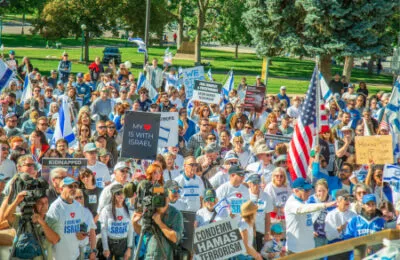Even before the Holocaust ended, Jewish leadership was considering how to commemorate those who had been brutally murdered by the Nazi regime.
In honor of International Holocaust Remembrance Day, January 27, Zack Rothbart of the National Library of Israel wrote about a gathering in Jerusalem in March, 1945, to address this very topic. By then world Jewry, and indeed the world, were well aware of the Nazi genocide. Indeed, Intermountain Jewish News readers were kept well informed throughout WW II of the perilous situation of their European brethren. Unlike national media, Jewish media rigorously reported on the fate of European Jewry.
Below is an edited version Rothbart’s piece. His full article can be found on the National Library of Israel “The Librarians” blog.
In March, 1945, the Allied victory was all but palpable, though carnage still raged across Europe. Auschwitz had been liberated at the end of January, yet almost all other major Nazi death camps were still operational.
Across the Jewish world, the all-but-incalculable toll of the Holocaust was increasingly calculated. Understood. Internalized.

IJN coverage from March 16, 1945 of the Jewish Community Council of Moscow’s call for a week of mourning.
One-third of all Jews in the world had been massacred.
On March 5, a gathering took place at the Hurva Synagogue in Jerusalem, deemed “the greatest Jewish synod to be held in the Holy City in modern times” by the Palestine Post, which reported that:
“… all the rabbis in Palestine assembled in conclave, from town and settlement, Sephardi religious leaders in their flowing oriental robes, side by side with Hassidic rabbis, among them the heads of the famous Sadagora [Sadigura] dynasty, and rabbis from Europe who had found shelter here from Nazi persecution…”
Sitting on the ground and unable to hold back their tears, the esteemed and diverse group of rabbinical leaders recited prayers and read from the Book of Lamentations. They chanted the Mourner’s Kaddish and blew the shofar seven times before walking together to pray at the Western Wall.

Months prior to the gathering, well before the Red Army reached Auschwitz, Rabbi Hizkiyahu Yosef Mishkovsky drafted a proposal, which he sent to leading figures in the Land of Israel, including prominent rabbinical organizations and the Jewish Agency. Mishkovsky was a leader of Polish Jewry who had come to Palestine at the turn of the 20th century, yet remained in close contact with the communities of Poland and Lithuania, often traveling back and forth before the war. He was also a leader of the Jewish Agency’s Rescue Committee, founded in 1942 with the goal of working to save European Jewry during the Holocaust.
His proposal recommended organizing a gathering of rabbis to focus on working to salvage what was left of European Jewry, while also grieving for its destruction by means of a seven-day mourning period and a permanent annual day of mourning and fasting.
Perhaps the most influential recipient of Mishkovsky’s proposal was Rabbi Yitzhak Halevi Herzog, the chief Ashkenazi rabbi of the Land of Israel, who soon thereafter hosted some 50 leading rabbis in his Jerusalem home to further discuss these recommendations.
The group declared that the Jews of Mandatory Palestine must open their homes to the survivors and that special efforts must be made to locate and save Jewish children hidden away in monasteries across Europe, ensuring that they come to the Land of Israel as soon as possible. Moreover, they declared that a national yahrzeit for the millions of victims must be proclaimed.
This meeting laid the foundation for the March 5 assembly at the Hurva Synagogue in Jerusalem at which Chief Rabbis Ben-Zion Meir Hai Uziel and Yitzhak Halevi Herzog, and the others present, called for a week of mourning throughout the Land of Israel, and “wherever these words reach,” to begin on March 8 and culminate with a fast day on March 14. They requested that during the week of mourning the public refrain from activities of leisure and entertainment, and that on the fast day itself, Jewish businesses and transportation would stop, as people dedicated time in synagogue and at home to mourn the victims.
Jewish communities across the globe adopted it, as did the Jews of Mandatory Palestine, religious and secular alike.
The act of Jewish solidarity was all but unprecedented in the annals of modern history, driven by rabbis who by today’s standards would be considered Religious Zionist and haredi, yet also being decisively adopted by the secular Zionist establishment and non-Orthodox movements globally.
From the capital of the Soviet Union, the Jewish Community Council of Moscow publicly expressed its observance of the week of mourning and the fast day, going so far as to also notify remaining Jewish communities and organizations across Europe about the initiative. The move in Moscow was hailed as historic and encouraging by Jews outside of communist controlled Eastern Europe.
The Synagogue Council of America, the umbrella group bridging the three major Jewish movements in the US, called for all of the country’s Jews to join in the communal mourning.
Survivors in Romania and Greece joined the international initiative.
Many communities throughout the British Empire — from Canada to South Africa to Australia — ignored the objections of their own chief rabbi, Joseph Hertz, one of few major contemporary Jewish leaders to oppose the initiative, and decided to mark the week of mourning with their coreligionists worldwide.
Even Jewish soldiers in the British Army stationed in Tripoli made plans to fast and observe the week of mourning by voluntarily confining themselves to their barracks, while in Mandatory Palestine, Jewish sailors in the Royal Navy attended a memorial service to mark the day.
The British High Commissioner for Palestine and Transjordan himself, Lord Gort, personally received the declaration from the chief rabbis, who also sent it via telegram to Winston Churchill, Franklin Roosevelt and Joseph Stalin, imploring them to not only remember the victims but also to allow the survivors to immigrate to the Land of Israel. Gort ordered that Jewish officials throughout Mandatory Palestine would be released from their duties on the fast day.
Commemoration of the fast day in British Mandatory Palestine was quite extensive, including a stoppage of work and traffic, and a complete “internal curfew” from 9 a.m. to 11 a.m.
Jewish police officers and schoolchildren donated money on the day to a rescue fund for Holocaust survivors.
The flags at the Jewish Agency building and the Polish consulate were flown at half-mast.
There had been previous calls for international days of Jewish solidarity and fasting, including a declaration by Rabbis Herzog and Uziel, not long after the outbreak of the war.
Yet nothing before (nor possibly since) seemed to compare to the response elicited by the March, 1945 initiative — which transcended virtually all boundaries and distinctions within the global Jewish community.
Perhaps the pain at the time was so raw and so real that Jews around the world — regardless of nationality or level of religious observance — were simply waiting for some sort of call to collective bereavement.
Some two months before the last camp was liberated, and six decades before the United Nations designated International Holocaust Remembrance Day, that call came from Zion.











